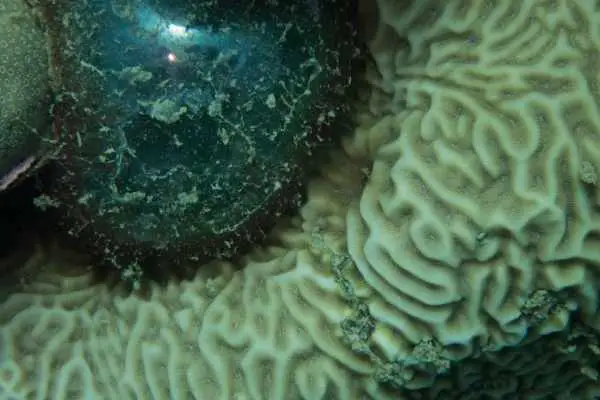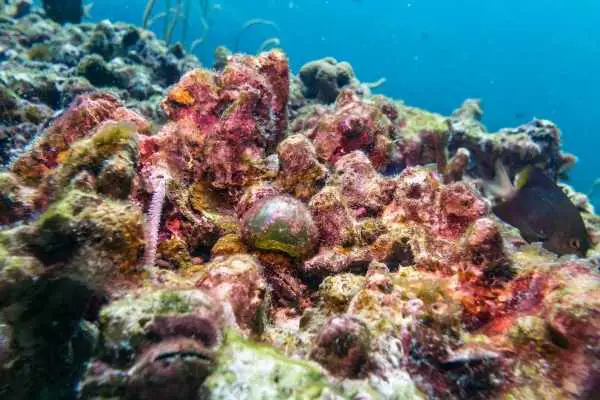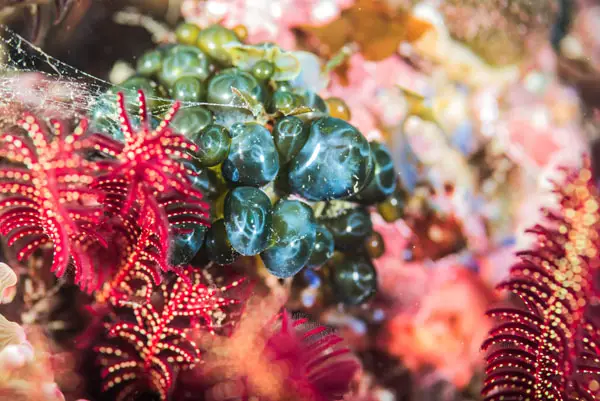You walk past your tank and notice a pearly green sphere tucked among the live rock. It looks attractive, so you leave it alone. Then more appear. And MORE. Before you know it, you’re combatting dreaded bubble algae. As pretty as those colorful colonies may be, it doesn’t take much for them to overtake a saltwater aquarium. (Under proper conditions) And removing these particular algae isn’t a simple task.
Table of Contents: Bubble Algae
As with any unwanted “pest” in your tank, bubble algae sneaks in when you’re not looking. Make that when you OVERLOOK it. And the species are easy to miss (you got it; there’s more than one). They survive in places you don’t expect to find little green things. (Plants – not aliens) That’s where understanding your enemy – courtesy of the links below – will help prevent unwanted infestations.
- What is Bubble Algae?
- Recognizing Bubble Algae in Your Tank
- Preventing Bubble Algae
- Removing Bubble Algae
- For More Information

What is Bubble Algae?
Bubble algae are members of the Class Ulvophyceae. And while some individuals reach impressive sizes (as large as a tennis ball in home aquariums), they’re actually unicellular. You got it, single-celled algae! Believe it or not, this common bane of hobbyists holds a place as one of the largest single-celled creatures on the planet. (If that doesn’t scream “alien,” what does?)
As unicellular organisms, bubble algae belong to the microalgae group. But when people see the more impressive growths out there, they think of macroalgae. Just remember: every sphere is ONE cell. (Even if it’s hard to believe) It’s part of the insidious nature of this aquarium pest.
Red and Green Bubbles
Most hobbyists reference one species of bubble algae: Valonia ventricosa. (You may see some people refer to it as Ventricaria ventricosa. However, that name isn’t officially accepted by WoRMS or the World Register of Marine Species) It forms the largest green bubbles, usually one at a time (though you CAN see colonies). However, there are multiple species in the group, and it’s possible to find any of them in your display tank:
- Boergesenia spp.
- Bornetella sphaerica
- Codium ovale
- Dictyosphaeria spp.
- Valonia spp.
Some bubble algae form tubular structures, others the spheres you’re more familiar with. They can produce clusters that quickly overtake an area or one lone, shiny “pearl.” And you may see a smooth, glossy surface or something that looks pitted or even slimy. Most of the time, hobbyists encounter shades of green in their bubble algae, but reds are possible, too.
You may see people refer to them as sea pearls or sailor’s eyeballs. (Fun, huh?)
And once you spot one of the spheres in your tank? You have more than one. Bubble algae never stop at one innocent green “pearl.”

Free-Floating Nuclei
So why is bubble algae such a persistent problem in aquariums? It’s what’s inside of that beautiful sphere. Remember, you’re dealing with a single-cell organism. So if you look inside of that shiny bladder (with a microscope), you’ll find THOUSANDS of free-floating nuclei in the cytoplasm. In other words, the building blocks for new algae. As soon as a bubble pops, nuclei explode into the water and seek a new place to settle and grow.
Sound dangerous? It is.
Rupturing the outer membrane of bubble algae is a sure-fire way to end up with an infestation. And the larger the sphere grows, the more delicate it becomes. Think of how many ways the ordinary life in your tank could damage that bubble. Fish and invertebrates going about their activities. You cleaning or moving aquascaping. One accidental bump with something sharp and…
Pow!
All of those nuclei spread through the tank in seconds, seeding fresh bubble algae EVERYWHERE. (And you thought Aiptasia was a pain!)
Recognizing Bubble Algae in Your Tank
Luckily, bubble algae are pretty distinct. Whether red, green, or somewhere in between, you’re going to see a fluid-filled, round structure put in an appearance. Hopefully. As the cell grows, it continues to swell. And plenty of hobbyists LIKE the look of those spheres. Unless you get one of the slimy species, there’s something attractive about a shiny green bubble nestled among your rock and coral.
The problem is when the bubble ruptures, spilling nuclei-filled cytoplasm. And it’s impossible to predict when that may happen. So keeping an eye out for bubble algae is crucial. And it’s not always easy to spot. That single-celled critter is sneaky, and it may already have found its way into your tank without you noticing.
Bubble algae LOVE to hitchhike into saltwater aquariums on live rock. Unlike their light-loving cousins, these species can tolerate dark conditions for months at a time. This means cells can hide out deep in the nooks and crannies of rock without a problem. They’ll also stay out of sight within coral plugs or discs.
Before you know it, you’ve added the first “seeds” of a raging infestation to your display tank. Keeping an eye out for any tell-tale bubbles is your best bet to prevent this scenario. And – pretty as they are – removing them before they start their doomsday timer.

Preventing Bubble Algae
As we mentioned, plenty of hobbyists allow bubble algae a coveted place in their tanks. And as long as you’re observing proper maintenance and control, you can roll the dice. The spheres DO add an extra touch of color and shape to your display. But you can’t slip up on your water quality. You also need to watch the growth of the bladder carefully. You don’t want an accidental explosion.
Most people would rather prevent an accidental infestation, though. It’s easier than coping with a nightmare removal. And since you’re dealing with a common hitchhiker – not to mention a plant-like organism – prevention isn’t tricky.
Quarantine
You know bubble algae’s most likely to enter a tank via live rock or coral plugs. And while you SHOULD cast a critical eye over any new acquisitions, there are plenty of deep pockets on each you can miss. You’re dealing with a unicellular creature. Sure, you’ll see a bubble – eventually. But the algae starts as a single cell (a tiny one). And it can happily survive out sight and out of mind.
So you want to quarantine all of your rockwork. Even your coral discs or plugs. Give them time to settle. This will allow the bubble algae a chance to grow and show itself. Then before you add your pieces to the display tank (or use them for your frags), you can repeat your examination. It’s the perfect time to remove any burgeoning spheres. And it should prevent the algae from establishing itself in your aquarium.
Water Quality
Bubble algae thrive in conditions with excess nutrients. If your tank contains high levels of nitrates or phosphates, you’re providing ideal growth media. Even if they’re single-celled, the species still behave like their more complex algae cousins. Where they find a wealth of nutrients, they’re going to make a home.
You don’t want to see your nitrates go above 20ppm. And your phosphates shouldn’t go above 0.03ppm. Checking your water parameters regularly will help you maintain a healthy tank environment.
If you’re still in the process of cycling your tank and you notice a sphere pop up, try not to panic. Get your water conditions under control and remove the offending bubble algae (don’t worry – we’ll get to that). Once the system balances, you shouldn’t see any new colonies emerge. Provided, of course, that you continue your due diligence.
Competition
Algae don’t play nice. (They never learned to share) So if you’re worried a bubble algae sphere may sneak into your tank, you can prevent an impending infestation by denying resources. Obviously, keeping a clean and healthy tank starts the process. But choosing to grow and nourish preferred algae species is the other route to take.
Coralline algae are the hobbyist’s best friend. You want to see this herald of a mature aquarium. But it also prevents bubble algae from gaining a foothold. They use the same nutrients. If you choose to nourish your tank with coralline algae spores (Coralline Algae in a Bottle), you’ll start the process off on the right foot.
Or you can grow a different competitor. Refugiums planted with macroalgae species such as Chaetomorpha provide valuable menu options for your herbivores. At the same time, you deny the nutrients those green bubbles need to grow and thrive. The competition WON’T eliminate the pest (an important distinction). However, when you have multiple algae fighting over the same pocket of resources, someone’s going to lose. Most of the time, it’ll be the lone (hopefully lone if you’ve done your screening) bubble alga cell.

“Housekeeping”
You can also employ natural “housekeeping” options to prevent bubble algae from gaining a foothold. If you have turbo snails in your tank, they’ll munch on the growing bladders in a SMALL state. This prevents the escape of those nuclei into the tank. (Think of how tiny a snail’s mouth is)
Now, turbo snails WON’T work if you already have an infestation. The poor gastropods can’t cope with larger spheres. And, honestly, you don’t want them to try biting into a fragile bubble. They’re handy on the prevention side of things ONLY.
Removing Bubble Algae
As beautiful as bubble algae can be, it IS a pest. Once a sphere grows large enough, it can cause problems. If the cell takes root under one of your corals, it can dislodge branches from the base. And if the bubble pops, you can end up with colonies clogging powerheads, skimmers, and filters. Not to mention ending up with an aquarium choked with those oh-so-attractive green spheres.
Removing the algae as soon as you spot it is the best course of action. You’ll save yourself a lot of heartaches. But it’s tricky. The last thing you want is a popped bubble. Because if you break it? Yeah, you bought it.
Physical Removal
While it sounds like playing a game of Operation (minus the buzzer), physical removal is the best way to eliminate a bubble algae plague. And the sooner your attempt the process, the better. Younger, smaller colonies aren’t as delicate as those giant, impressive spheres. That offers you a touch more wiggle room. You still want to be as careful as you can.
And that means gathering the proper materials:
- Gloves
- Flathead screwdriver or chisel
- Airline tubing
- Siphon
- Filter sock
- Bucket
Even if it’s tempting to scrape tiny bubbles off live rock with your fingernail, don’t. The risk of injury is too high. You don’t want to slip, slice your finger on the rock, and land yourself at the doctor with an infection. A sharp tool is your best bet. You need to get ALL of the algae, and fingernails won’t do the trick.
Set the filter sock in the sump if you have one attached to your tank. You want the siphon to run into the filter sock. This will allow you to safely collect the algae and prevent any escapes into the tank. Siphon into a spare bucket if you don’t have a sump or sock.
- Wedge the screwdriver/chisel under the algae at the “root.”
- You shouldn’t need more than a twist to pull it loose.
- Utilize your siphon or airline to collect the bubble.
If you can, remove the entire piece of rock from your tank. Then you can work in a separate bucket of saltwater. (To the peace of your fish and invertebrates) You still want to observe the same precautions, or you’ll reseed the rock with nuclei.
Having suction handy will prevent the bubble algae from getting away from you. The last thing you want is to get the pest free of the rock and have it drift out to settle somewhere else in the tank. (Which it WILL do) Ideally, you don’t want to rupture that sphere in the process, but your siphon should manage to gather all of the cytoplasm, just in case.

Biological Warfare
If you’re willing to adopt a more patient route for your bubble algae removal, you can pick up a bottle of Vibrant. Vibrant’s nothing more than beneficial bacteria. And all you’re doing is implementing another form of competition – minus the algae.
The bacteria step in and absorb the nutrients the algae need to survive. It’s a supplement measured out CAREFULLY over several weeks. If you go too fast, you’ll destroy all of the plant life in your aquarium and send your nitrate levels skyrocketing. It WILL destroy the algae, but it’ll also present problems for your fish and invertebrates.
Vibrant works for plenty of nuisance algae. And the bacteria are natural. You just need to have patience while it goes to work.
“Housekeeping”
While preventing bubble algae doesn’t offer much on the “housekeeping” side of the equation, you have a few more options when it’s time to eradicate the problem. Of course, you need to keep a couple of warnings in the back of your mind.
First, there’s no such thing as a 100% herbivore. Aquatic species that fall under that label still consume meaty proteins. So while plenty of people reference certain species as bubble algae eradicators, the critters WILL occasionally sample some of your other tank inhabitants, including coral polyps, zoanthids, and even fish. This can lead to additional problems.
Second, species that DO eliminate your algae problem need plans. What are you going to do once your plague’s gone? You don’t want the animal to die. That’s not healthy for the tank (or the creature). Do you know someone else that can take over its care? Will the store you purchased it from accept a return? Have some idea of the next step before picking up a species with a special diet.
That said, these species will help pitch in when you’re coping with bubble algae woes:
- Blennies
- Emerald crabs
- Sea hares
- Sea urchins
For More Information
Bubble algae look attractive. Well, until they take over your aquarium. Then they turn into an absolute horror. And handling those delicate spheres is challenging. Avoiding the problem in the first place is the best course of action. But that isn’t always possible (sneaky single-celled organisms). So if you’re fretting over an explosion of green bubbles throughout your tank, fret not. There are a few more key points for you below.
Such as this YouTube video explaining how to beat bubble algae in saltwater aquariums:
Or this one, which offers even more tips on removing those green bubbles:
Curious about other problematic algae out there?
Ready to roll the dice and find a nice “housekeeping” species to control your bubble algae problem:
Conclusion
Not every hobbyist despises bubble algae. Some enjoy the look the shiny spheres add to their display tanks. They also take pains to ensure water quality stays in peak condition. This prevents further outbreaks of the pest. And the hobbyists are EXCEPTIONALLY careful around the delicate bubbles to prevent accidental ruptures. It’s an option for every aquarium.
But if you’d rather not take the risk, never miss a quarantine. Or keep friendly algae species in your tank for a bit of healthy competition. And if you DO spot one of those “innocent” bubbles, don’t pop it. You don’t want to set off an invasion.
References
- Cortes-Jorges Jr., H. “‘Bubble’ Algae: Selected Descriptions, Controls, and Comments.” Reefkeeping.
- Kurtz, J. 2013. “End the Toil and Trouble of Bubble Algae.” ReefBuilders.


Leave a Reply